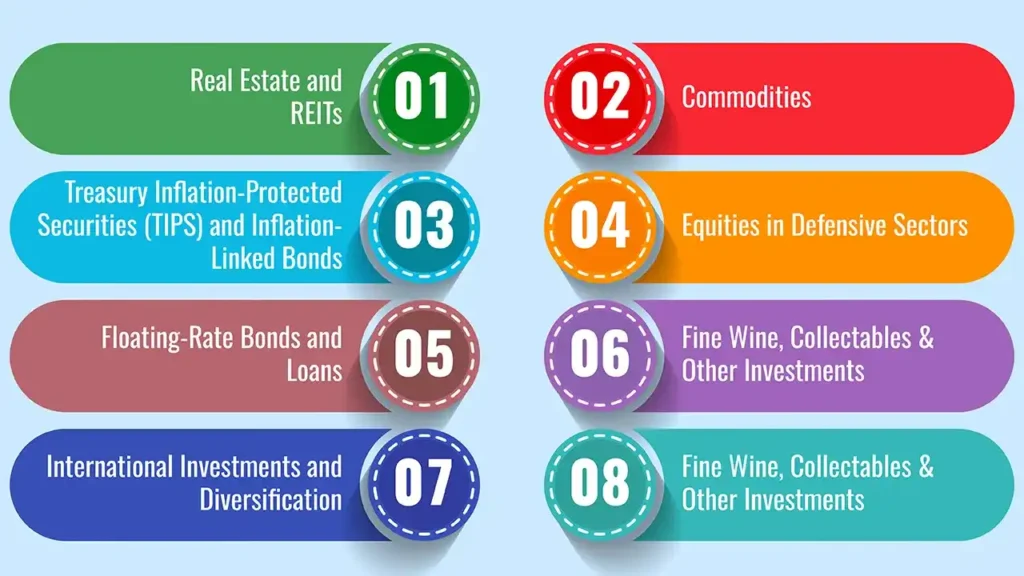In 2025, more than ever, you must look for trustworthy investment strategies to safeguard your wealth because inflation is a merciless, slow, and unseen thief that progressively devalues your hard-earned money over time.
As cost-of-living increases have continued to outpace wage growth and savings rates have remained low, investors are looking for options that can withstand economic headwinds. An emerging trend is thought to be that of inflation proof assets, providing both the ordinary person and businesses with an avenue to insulate themselves from the adverse impacts of inflation.
In this comprehensive guide, we take a deep dive into the 8 Ways of Inflation Proof Assets (2025) and help readers clarify what assets offer protection and how to best integrate them into financial planning. Keep reading to learn how each asset class can create long-lasting, inflation-beating portfolios in the current market environment.
Here are the 8 Ways of Inflation Proof Assets (2025)

1. Real Estate and REITs
Hard assets Hard assets, such as property, have been a go-to investment for hedging against inflation for some time. Direct ownership of real estate results in rental income, which tends to increase with inflation, offering both income and appreciation. But not everyone is able to purchase physical property, and REITs are a great option for them.
REITs allow you to gain access to real estate markets while providing liquidity and easier entry. Rising with inflation As properties are revalued and rental income increases, REITs have the ability to reset rental income streams, making them contenders for the Inflation-Proof Assets list. Expanding into commercial, residential, and even speciality REITs further broadens the protection it offers.
2. Commodities
Classic Inflation Proof Assets – commodities – gold, wheat, corn, metals (like aluminium, copper, etc.), oil and natural gas. Commodity prices generally rise as input costs and currency values decline, creating a cushion against weakening purchasing power.
Investors most often get exposure through commodity-centric funds, futures or ETFs. Gold deserves an honourable mention as a centuries-old hedge against inflation by virtue of being a store of value, especially in the face of financial instability. Commodities can also help to diversify returns and add stability when traditional assets buckle under the pressure of inflation.
3. Treasury Inflation-Protected Securities (TIPS) and Inflation-Linked Bonds
TIPS and other inflation-indexed bonds are securities that the government issues which are structured as inflation proof assets. Their principal and interest payouts increase with official inflation, ensuring that the real value of both the payouts and the investment itself is maintained.
The tips offer a direct way to hedge against inflation and can be purchased directly or through mutual funds or ETFs. Their baseline yields may not always be as high as those of ordinary bonds, but conservative investors who want a degree of protection from inflation find the fact that inflation gets figured in automatically extremely appealing.
4. Equities in Defensive Sectors
Some stocks (especially from “defensive” sectors like energy, utilities, and consumer staples) may qualify as inflation proof assets. Companies in these industries frequently have the pricing power to push higher costs on to consumers, which in turn protects profit margins.
Stocks that pay stable dividends and have strong fundamentals add another layer of protection from inflation. Even as inflation moves its way throughout the broader stock market, causing volatility, defensive sectors are an effective buffer as they continually churn out profits in all economic environments.
5. Floating-Rate Bonds and Loans
Floating-rate assets are becoming more popular as inflation proof assets because their interest payments increase when prevailing rates go up — often the result of inflation. Bank loans and floating-rate bonds and funds that hold these instruments offer the potential for higher rates of interest in inflationary climates.
These assets offer a bet against bond price declines when rates rise on inflation. They’re particularly appealing for anyone who craves ongoing income with no loss of purchasing power from fixed payments.
6. Fine Wine, Collectables & Other Investments
Non-traditional assets such as fine wine, art, classic cars and other collectible assest can also fall into this category of inflation proof assets. Nor are these categories closely correlated with stock or bond markets and can appreciate substantially as they become more scarce or as demand rises during inflationary periods.
However, such assets, although sector-specific in nature, can provide attractive long-term returns and diversify an investment portfolio. In addition, it’s easier than ever for retail investors to get in on this kind of inflation-hedging investment with institutional platforms that enable access.
7. International Investments and Diversification
Currency risk and global wealth and income disparities create conditions in which inflation can arrive unevenly across different economies and at different speeds. Diversifying into international inflation proof assets (like foreign stocks, real estate, and bonds) across geographic areas provides another level of insulation.
By investing globally, investors can tap opportunities where local inflation is less or where currencies are strengthening versus their home country. International diversification is still an advisable method to decrease portfolio exposure to risk.
8. Private Infrastructure and Tangible Assets
Many infrastructure deals, whether for toll roads, utilities, transportation or energy, include revenues that are indexed against inflation measures. They are real IPAs with long-term contracts and regulated price increases that can deliver an income adjusted for inflation.
Private infrastructure investments – sometimes accessed via funds – also generate regular yield and serve as a defensive investment during stormy investment waters, with inflation-proofing coming from being an essential asset class with the contractual back-up to support such claims.
Conclusion
Constructing a sturdy financial future involves more than crossing your fingers that inflation will continue to be under control; it’s about intentionally adding inflation proof assets to an investment strategy. Using the 8 ways of inflation-proofing assets (2025)—real estate and REITs, commodities, inflation-linked bonds, defensive equities, floating-rate assets, collectibles, global diversification, and infrastructure—investors can construct an all-weather portfolio: one that’s robust against the erosional style of inflation.
Allocation among these asset classes in a disciplined way ensures that people can maintain purchasing power, get income that will be there for the future and build wealth for the next generation. In the present context of continued economic uncertainty, the utility of well-chosen inflation proof assets for sustainable investment has not been more relevant.
Frequently Asked Questions (FAQs)
3. What are Inflation Proof Assets?
Inflation-borrow assets are investments that hold their value or increase in value in inflationary periods, protecting the purchasing value of an investor’s money.
2. Why should I have Inflation Proof Assets in my portfolio?
By including inflation-proof assets, your wealth can grow, if not at least keep pace with the rising cost of goods and services, shielding you from unexpected economic shocks.
3. How Do REITs Work as a Hedge Against Inflation?
However, REITs own real estate, which is an asset class that benefits from inflation as the income and value of the asset go higher in the period of inflation, providing both value protection and income protection.
4. Do commodities provide a decent hedge against inflation?
Yes, they are the best guide for any investor looking for time-tested inflation-proof assets to “hedge” against higher inflation; they hedge it higher, NOT going lower in price.
5. What made TIPS an interesting choice for inflation protection?
TIPS are government bonds with payouts tied to inflation rates, so their returns surge with the Consumer Price Index in a way that protects their real value.

Leave a Reply